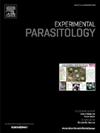Structural insights into Trichuris muris eggs through 3D modeling, Cryo-SEM, and TEM of samples prepared with HPF-FS
IF 1.6
4区 医学
Q3 PARASITOLOGY
引用次数: 0
Abstract
Trichuriasis – a disease caused by Trichuris trichiura – affects underserved communities. Infection occurs by the ingestion of embryonated eggs, a resilient structure against environmental fluctuations – an essential feature for the survival and transmission of trichurids. This study aims to enhance our comprehension of the trichurid eggs by providing a characterization of the ultrastructure of eggshell and first-stage (L1) larvae of T. muris, a key experimental model for trichuriasis. We employed the following microscopy techniques: light, fluorescence, confocal, Cryo-SEM, and Transmission electron microscopy (TEM), analyzing unfixed, chemical and cryofixed samples. Light microscopy revealed the structure of the eggshell, consisting of three main layers: Pellicula ovi (PO), chitinous layer (CHI), and the electron-dense parietal coating (EdPC). Fluorescence microscopy showed the calcein's high affinity for the eggshell and polar plugs, while the DAPI distinctly stained the L1 larval cells. Using confocal microscopy and 3D modeling, we quantified an average of 151 larval cells. TEM of high-pressure frozen and freeze-substituted samples revealed that the PO and the EdPC layers lacked sublayers, while the CHI layer was composed of 12–14 sublayers. The CHI also contained continuous distinct organization structure forming the polar plugs. The combination of different sample fixation methods and advanced imaging techniques was crucial for revealing structural details of both the eggshell and L1 larva, including the arrangement of cells, cuticle, and an anterior pointed structure. These findings provide deeper insights into the structural biology of T. muris and offer valuable information for advancing parasite control strategies in both human and veterinary context.

通过HPF-FS制备的样品的3D建模,Cryo-SEM和TEM,深入了解鼠毛线虫卵的结构。
滴虫病——一种由滴虫引起的疾病——影响服务不足的社区。感染是通过摄入胚胎卵发生的,这是一种抵御环境波动的弹性结构,是三趾虫生存和传播的基本特征。本研究旨在通过对三趾虫卵(trichurids的关键实验模型T. muris)的蛋壳和第一阶段(L1)幼虫的超微结构进行表征,以提高我们对三趾虫卵的认识。我们使用以下显微镜技术:光,荧光,共聚焦,冷冻扫描电镜和透射电子显微镜(TEM),分析未固定,化学和冷冻样品。光镜显示蛋壳的结构主要由三层组成:卵壳层(Pellicula ovi, PO)、几丁质层(chitinous layer, CHI)和电子致密的顶层(electron-dense顶膜,EdPC)。荧光显微镜显示钙黄蛋白对蛋壳和极塞有很高的亲和力,而DAPI明显染色L1幼虫细胞。利用共聚焦显微镜和三维建模,我们对151个幼虫细胞进行了定量分析。高压冷冻和冷冻替代样品的透射电镜显示,PO和EdPC层缺乏亚层,而CHI层由12-14个亚层组成。CHI还包含连续的、独特的组织结构,形成极塞。不同的样品固定方法和先进的成像技术的结合对于揭示蛋壳和L1幼虫的结构细节至关重要,包括细胞、角质层和前尖结构的排列。这些发现为鼠形绦虫的结构生物学提供了更深入的见解,并为在人类和兽医环境中推进寄生虫控制策略提供了有价值的信息。
本文章由计算机程序翻译,如有差异,请以英文原文为准。
求助全文
约1分钟内获得全文
求助全文
来源期刊

Experimental parasitology
医学-寄生虫学
CiteScore
3.10
自引率
4.80%
发文量
160
审稿时长
3 months
期刊介绍:
Experimental Parasitology emphasizes modern approaches to parasitology, including molecular biology and immunology. The journal features original research papers on the physiological, metabolic, immunologic, biochemical, nutritional, and chemotherapeutic aspects of parasites and host-parasite relationships.
 求助内容:
求助内容: 应助结果提醒方式:
应助结果提醒方式:


